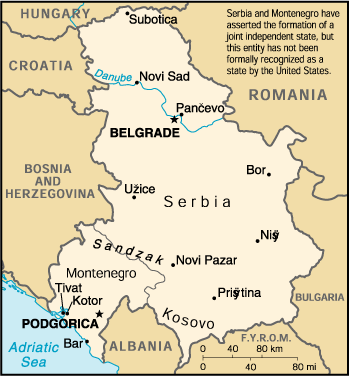A brief summary of the history of Yugoslavia (Serbia) is nearly impossible. Its history spans over one thousand years, and its location as the major land route between Turkey (the Middle East) and Europe has much to do with the complexity of that history.
First, however, we should look at what makes Kosovo such an important piece of land in Yugoslavia’s history. The Turkish Ottoman Empire was extending its rule outward into the domain of the Byzantine Empire (Christian). In their efforts to invade Europe, the Serbs were directly in the path. On June 15, 1389, the forces of Serbian Prince Lazar and Ottoman sultan Murad I met at Kosovo Field (Kosovo Polje or "Field of the Blackbirds"). The Serbs lost the battle, and tens of thousands of men. Though Murad I was slain, his son, Bayezid, took command and continued the campaign. The region has some of the oldest monasteries of the Serbian Orthodox Church.
Let’s look at how the Central Intelligence Agency looks at Serbia, as recently as 1998. Just one year ago, the CIA Worldbook recognized Serbia and Montenegro as, well, let’s use the CIA’s own words, "Serbia and Montenegro have asserted the formation of a joint independent state, but this entity has not been formally recognized as a state by the US; the US view is that the Socialist Federal Republic of Yugoslavia (SFRY), has dissolved and that none of the successor republics represents its continuation.
Let’s look at the CIA’s map of the region:
Note that Bosnia and Herzegovina, Croatia, Hungary, Romania, Bulgaria, Macedonia (F.Y.R.O.M.) and Albania surround the two nations. There is a line separating Montenegro from Serbia, but Kosovo is included within the boundaries of Serbia.
Doesn’t it seem rather surprising that our own CIA doesn’t see Kosovo as a nation unto itself, but that the United States, and their lackey, NATO do? Or, do NATO and the United States recognize the right of any state (district) to secede from its parent, on strictly religious principles? Both the NATO charter and the Constitution for the United States of America prohibit seceding.
What the United States and NATO are supporting, in this instance, could be likened to San Antonio, Bexar County and the Alamo being returned to Mexico because there are more Mexicans in the area than there are Texans. Do you believe that the Texans would be willing to fight to keep the Alamo? Then, are we surprised when Serbian unity increases as foreign interests try to take away their heritage – after hundreds of years of attempting to retain it?
Would you help the Texans take on the Mexicans? Would you help the Texans take on the United States (if they had granted the Mexicans the right to secede)? Will you help the Serbians retain what currently belongs to them, and, is rightfully theirs? Then, perhaps, you might just consider taking on the United States!
Return to Waco II -- Serbia Index
